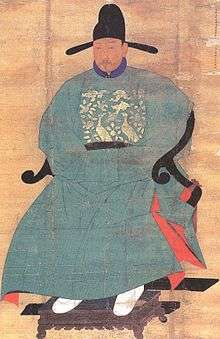Sin Sukju
Sin Suk-ju (Korean: 신숙주, hanja: 申叔舟; August 2, 1417 – July 23, 1475) was a Korean politician during the Joseon Dynasty. He served as Prime Minister from 1461 to 1466 and again from 1471 to 1475.
| Shin Sukju | |
 | |
| Korean name | |
|---|---|
| Hangul | 신숙주 |
| Hanja | 申叔舟 |
| Revised Romanization | Sin Suk-ju |
| McCune–Reischauer | Sin Suk-chu |
| Pen name | |
| Hangul | 희현당 or 보한재 |
| Hanja | 希賢堂 or 保閑齋 |
| Revised Romanization | Huihyeondang or Bohanjae |
| McCune–Reischauer | Hŭihyŏndang or Pohanjae |
| Courtesy name | |
| Hangul | 범옹 |
| Hanja | 泛翁 |
| Revised Romanization | Beomong |
| McCune–Reischauer | Pŏmong |
| Posthumous name | |
| Hangul | 문충 |
| Hanja | 文忠 |
| Revised Romanization | Munchung |
| McCune–Reischauer | Munch'ung |
Shin was an accomplished polyglot, and was particularly well educated in the Chinese language.[1] He served as a personal linguistic expert to King Sejong, and was intimately involved in the creation and application of the Korean alphabet known in modern times as Hangul.[1] Sin used the newly created hangul system to create an accurate transcription of spoken Mandarin Chinese in 15th century Ming dynasty China.[1][2] These transcriptions haven proven accurate and reliable, and his transcriptions are now "an invaluable source of information on the pronunciations of Ming-era [Mandarin]."[1]
Popular culture
- Portrayed by Lee Hyo-jung in the 2011 KBS2 TV series The Princess' Man.
See also
- Han Myung-hoi
- Jeong In-ji
- Kwon Ram
- Hong Yun-seong
- Hong Dal-son
References
- Footnotes
- Handel (2014): 294.
- Coblin, W. South (2000), "A Brief History of Mandarin", Journal of the American Oriental Society, 120 (4): 537–552, JSTOR 606615
- Works Cited
- Handel, Zev (2014). "Why Did Sin Sukju Transcribe the Coda of the Yào 藥 Rime of 15th Century Guānhuà with the Letter ㅸ <f>?". Studies in Chinese and Sino-Tibetan Linguistics: Dialect, Phonology, Transcription and Text, eds. Richard VanNess Simmons, Newell Ann Van Auken. Language and Linguistics Monograph Series 53. Taipei: Academia Sinica, pp. 293–308.
External links
- Shin Suk-ju (in Korean)
- Shin Suk-ju:britannica (in Korean)
- Shin Suk-ju:Nate (in Korean)
| Wikisource has original text related to this article: |